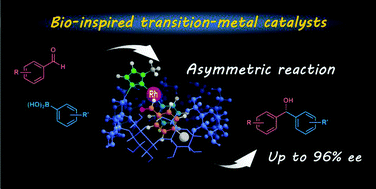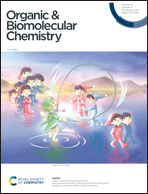Bio-inspired asymmetric aldehyde arylations catalyzed by rhodium-cyclodextrin self-inclusion complexes†
Abstract
Transition-metal catalysts are powerful tools for carbon–carbon bond-forming reactions that are difficult to achieve using native enzymes. Enzymes that exhibit inherent selectivities and reactivities through host–guest interactions have inspired widespread interest in incorporating enzymatic behavior into transition-metal catalytic systems that highly efficiently produce enantiopure compounds. Nevertheless, bio-inspired transition-metal catalysts that are highly enantioselective and reactive have rarely been reported. In this study, we applied γ-cyclodextrin-imidazolium salts to the rhodium-catalyzed asymmetric arylations of aldehydes. The method exhibits wide substrate scope and the corresponding arylcarbinols are obtained in excellent yields under optimized conditions, with enantiomeric excesses of up to 96% observed. Kinetic and competition experiments revealed that self-inclusion of the Rh complex contributes to the high enantioselectivity and reactivity achieved by this catalytic system. Thus, this bio-inspired self-inclusion strategy is promising for the development of highly enantioselective and reactive transition-metal catalysts for asymmetric carbon–carbon bond formation.

- This article is part of the themed collection: Supramolecular chemistry in OBC


 Please wait while we load your content...
Please wait while we load your content...